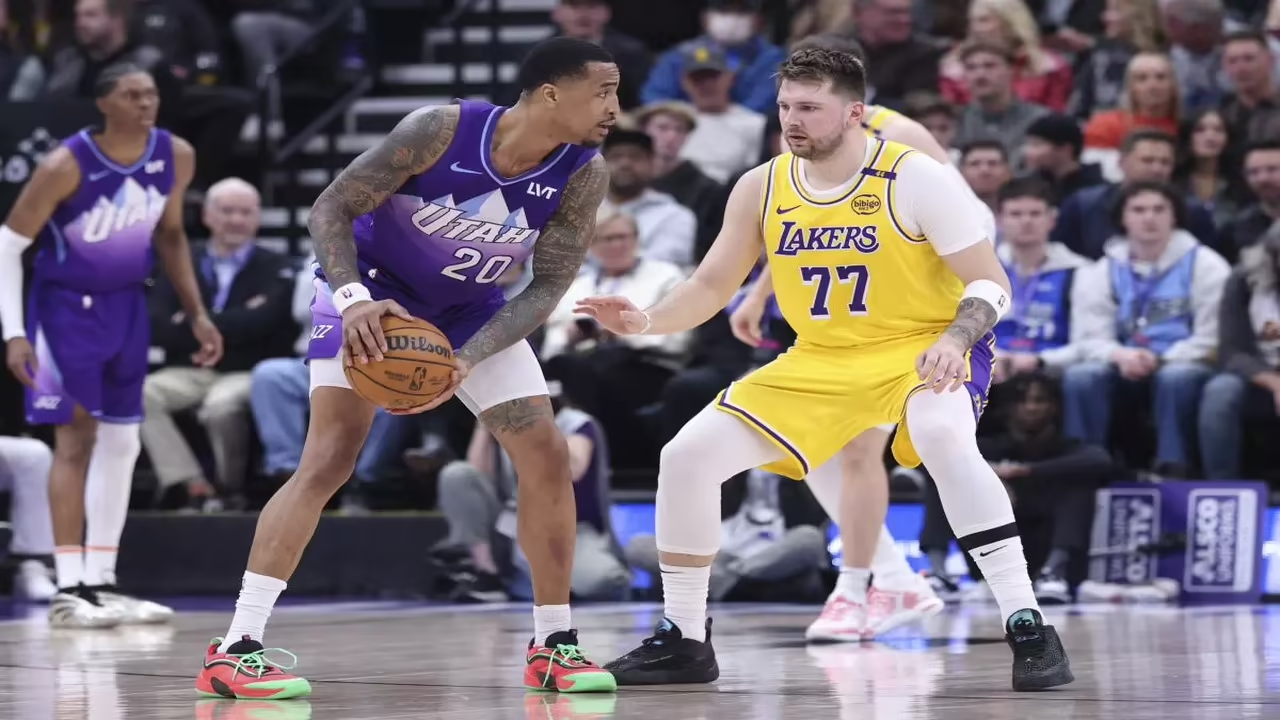Game Overview
The recent matchup between the Utah Jazz and the Los Angeles Lakers was a significant event in the ongoing NBA season, capturing the attention of fans and analysts alike. The final score of the game concluded with the Lakers securing a narrow victory, underscoring the competitive nature of both teams. The outcome was pivotal, not merely in terms of statistics, but also for establishing team morale and playoff implications heading into the later stages of the season.
Throughout the game, both teams displayed distinct strategies influenced by their current standings. The Utah Jazz applied an aggressive offensive approach, relying on sharp shooting and quick ball movement to capitalize on open opportunities. Conversely, the Lakers maintained a more defensive posture, emphasizing their ability to control the paint while executing fast breaks to create scoring chances. This tactical divergence played a pivotal role in the flow of the game and reflected the strengths of both teams.
Several key moments defined the contest, including crucial three-pointers from the Jazz in the fourth quarter, which momentarily shifted momentum. However, the Lakers countered effectively with strong defensive plays, including steals and blocks, which underscored their commitment to defensive stability. The performance of individual players was particularly noteworthy; both teams showcased rising stars and established veterans, which contributed significantly to the statistics and overall excitement of this match. Observers noted various player stats that highlighted their contributions, with some players achieving career-highs or significant milestones, emphasizing the ongoing evolution of both rosters.
As the season progresses, the implications of this Utah Jazz vs Lakers match will likely resonate, influencing each team’s strategy moving forward. The analysis of this game not only sheds light on the current player stats but also offers insights into potential trends that may emerge as the playoff race heats up.
Key Players’ Performance
The Utah Jazz and the Los Angeles Lakers have been two prominent teams in the NBA, each showcasing exceptional talent. The performances of selected key players during their match significantly influenced the outcome, with individual statistics shedding light on their contributions.

For the Utah Jazz, standout performances came from their star guard and center. The guard, known for his scoring ability, recorded a remarkable 30 points, alongside 8 assists and 5 rebounds. His shooting efficiency was notable, hitting 50% of his shots from the field, which included crucial three-pointers that shifted momentum in favor of the Jazz. Additionally, his defensive efforts reflected as he tallied 2 steals, allowing his team to capitalize on turnovers.
On the other hand, the Lakers consistently rely on their star player, who delivered an impressive show with 28 points, 10 rebounds, and 7 assists. His ability to dominate in the paint was evident, leading to a shooting percentage of 55%. The veteran leadership of this player not only inspired teammates but also included clutch moments that kept the game competitive. He assisted on several fast-break opportunities, showcasing his versatility on the court.
Another key contributor for the Lakers was their forward, who had a significant impact with 15 points and 6 rebounds. His hustle on both ends of the court led to vital second-chance points, demonstrating the importance of teamwork and effort in the match. Overall, the player stats from the Utah Jazz vs Lakers match highlighted how individual talents can intertwine to form a competitive gaming environment, with both teams showcasing their best throughout the encounter.
Comparative Player Analysis
In examining the recent Utah Jazz vs Lakers match player stats, a critical appraisal of the performance metrics reveals key insights into both teams’ dynamics. The matchup showcased a variety of player positions, including point guards, forwards, and centers, each contributing uniquely to their respective teams. Let’s delve into the stats for these key positions, which serve as a barometer for player performance and overall team effectiveness.
Starting with the point guards, the performance of the Jazz’s playmaker was marked by precise assists and an efficient shooting percentage. In contrast, the Lakers’ point guard displayed a higher scoring output but struggled with turnovers. This dichotomy illustrates the delicate balance between playmaking and scoring, wherein each player’s style influenced their team’s flow. Analyzing these statistics helps to frame the effectiveness of each player, ultimately playing a pivotal role in the outcome of the match.
The performance of forwards on both sides was equally compelling. The Utah Jazz’s forwards excelled defensively, with a higher number of rebounds and steals, showcasing their ability to disrupt the Lakers’ offensive strategies. Conversely, the Lakers’ forwards demonstrated strong scoring capabilities and versatility but were occasionally hampered by defensive lapses. This contrast highlights the range of strengths and weaknesses across both teams, particularly in how these forwards interacted in scoring and defensive situations.
Lastly, the analysis of center positions revealed a close contest in terms of scoring and rebounding. The Jazz center dominated in points per shot attempt, yet the Lakers’ center provided significant defensive presence. The varying player stats in these key positions offer valuable insight into future matchups and potential strategies by illustrating how each team leverages its strengths while attempting to exploit its opponent’s weaknesses. Such detailed evaluation of the Utah Jazz vs Lakers match player stats is essential for understanding these teams’ competitive landscape.
Future Implications and Takeaways
The statistical performance of players during the Utah Jazz vs Lakers match presents several critical implications for both teams as they navigate their respective seasons. Analyzing the match player stats provides insights that may shape future game strategies, highlight areas needing improvement, and foster player development. For the Jazz, the performance of key players such as their leading scorer reflects a need to enhance offensive consistency. If they can leverage the strengths observed in this match, particularly in ball movement and shooting accuracy, it could lead to more favorable outcomes in subsequent games.
Conversely, the Lakers also need to address the defensive gaps exposed during this matchup. The player stats indicate that the Jazz capitalized on mismatches and open shooting opportunities. This could prompt the Lakers to reevaluate their defensive schemes, focusing on better communication and understanding among players. Menacing matchups sometimes resulted in breakdowns, leading to scoring runs from the Jazz. By working on synergy and developing a robust defensive strategy, the Lakers can aim to limit opposing teams’ offensive efficiency in future encounters.
Moreover, the statistical performance correlation between individual players and team chemistry will be essential moving forward. A single match may not dictate a season, but trends in performance, as highlighted by the Utah Jazz vs Lakers match player stats, could signal potential growth areas. As players learn to adapt and collaborate more effectively on the court, we may witness noticeable improvements in handles, shot selection, and defensive awareness. Overall, this match serves as a vital benchmark, providing lessons in effectiveness that both teams can integrate into their game plans for enhanced performance in the upcoming challenges.






Leave a Reply